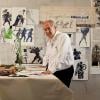
There are everyday chamber operas, and then there are the works conceived and directed by South African artist William Kentridge.
Kentridge’s The Great Yes, The Great No, which is being presented Feb. 5–8 at the Wallis Annenberg Center for the Performing Arts in Beverly Hills and March 14–16 at Cal Performances in Berkeley, is an opera that is also part play, with a Greek chorus thrown in for good measure.
Based on actual events, the work involves a who’s who of mid-20th-century thinkers, including French surrealist André Breton, French anthropologist Claude Lévi-Strauss, and Cuban artist Wifredo Lam, depicting their historic escape from Vichy France on a cargo ship sailing from Marseille to Martinique.
But the opera also mixes in fiction with that history, augments reality, and invites other renowned figures onto the vessel in an allegorical depiction of forced sea crossings of the past and present. Told in French, English, and South African languages such as Xhosa and Setswana, The Great Yes, The Great No incorporates acting, movement, shadow play, film, music, and photography. The libretto was created from literary extracts, built primarily on Martinican poet Aimé Césaire’s 1939 anti-colonial poem Cahier d’un retour au pays natal (Notebook of a return to the native land). The score was composed by Nhlanhla Mahlangu, who is also an associate director of the piece along with Phala O. Phala.

Mahlangu met Kentridge in 2017 and worked on the artist’s 2019 opera Waiting for the Sibyl. Speaking from South Africa over Zoom, Mahlangu described the work’s development, beginning with the creative team’s initial discussions. “[Kentridge] would have a theme, and he would have fragments — drawings about the subject and fragmented ideas of what is possible — and visual ideas because he’s a visual artist.
“When he came to me, he had a phrase: ‘The world is leaking, the dead report for duty, and women pick up the pieces.’ Who is the voice of the world that is leaking? The world is described as a she, and we’re in a ship [also] described as a she, and the ocean is described as a she. When we’re deep in the ocean, when you look at it as the place where life came from — life started in the water — you’re looking at woman as the maker of life.”
If that sounds heady, well, it is. Mahlangu, 45, pointed out that Kentridge, who’s directed numerous productions at major opera houses, including Mozart’s The Magic Flute and Dmitri Shostakovich’s The Nose, uses what is “available to him as a visual artist. He’s interested in the human spirit that carries these bodies. This is where he invites me to excavate that. He provides a horizontal progression of the work; I provide the vertical progression of the work.” The composer added that Kentridge “sees bodies as sculptures, so a seaman’s body standing onstage singing is an artwork that interacts with the shadow and what’s behind and in the foreground.”

Mahlangu explained that he invited singers to participate based on suggestions from Kentridge about what was required. He observed that in this production, “it was important that we invite a chorus of seven women. There’s something about power in the number seven, [which is] a number of wholeness and totality that allows us not only to find balance in harmonies but also to invite singers who are independent [performers and musicians] in their own right.”
Mahlangu admitted that “it was amazing to [get to] write the music.” He described his unique composing process: “I don’t go home, write the music, and then bring it to the singers. I study dance. I work from the body and the somatic memory. What is it that you are unable to articulate but your body remembers very well? How do we find meaning out of that and start investigating words together?”
His approach also involves the singers in the writing itself. “They don’t necessarily sing music imposed on them. They breathe melodies into the stories we’re finding together. They breathe words. I sit in a room and inspire a way of working with them.”
The score’s instrumentation — banjo, upright piano, cello, accordion, and a makeshift drum kit, with all of the musicians onstage led by the production’s music director, Tlale Makhene — mirrors the different nationalities of the story. The banjo, for instance, reflects the many transatlantic journeys, musical and otherwise, that have connected Africa, the Caribbean, Europe, and the United States, relationships that Mahlangu worked to capture in his score. “What is the music of Martinique? What is the music of France, of South Africa? We live in the body that is South African; we have to carry the South African voice. When we travel from France, you hear French cafe music. We go into Martinique; you hear their music. It was important that we appropriate these elements.”

In Kentridge’s telling of the narrative, the cargo ship’s mythical captain, Charon, also brings a number of imaginary passengers on board. Included are figures such as Césaire and his wife Suzanne, Martinican philosopher and activist Frantz Fanon, dancer-singer-actress Josephine Baker, and Joséphine Bonaparte, who was born to settler colonists on Martinique before becoming empress of France. Joseph Stalin and Leon Trotsky have walk-on parts. All of the performers wear large masks bearing their characters’ likenesses.
There’s a hint of the opera’s overarching theme in the title. As Mahlangu said, “It’s about optimism and pessimism. It’s about one man’s meat is another man’s poison. It’s about hope and despair at the same time, ugliness and beauty that live together. It’s about the anti-binary that the world is. It’s about fluidity of situations. Everything collapses into the air. [And] William Kentridge may have a different explanation for this — which is great.”




